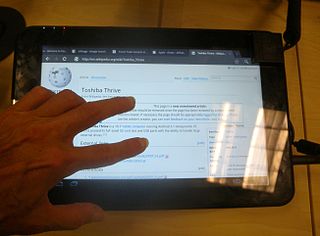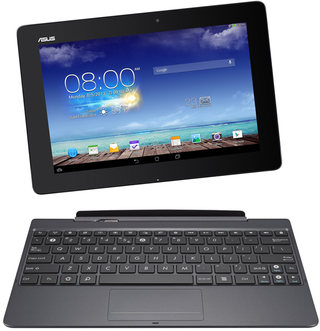
A tablet computer, commonly shortened to tablet, is a mobile device, typically with a mobile operating system and touchscreen display processing circuitry, and a rechargeable battery in a single, thin and flat package. Tablets, being computers, have similar capabilities, but lack some input/output (I/O) abilities that others have. Modern tablets largely resemble modern smartphones, the only differences being that tablets are relatively larger than smartphones, with screens 7 inches (18 cm) or larger, measured diagonally, and may not support access to a cellular network. Unlike laptops, tablets usually run mobile operating systems, alongside smartphones.
Velocity Micro is a privately held boutique computer manufacturer located in Richmond, Virginia (USA), specializing in custom high-performance gaming computers, professional workstations, and high-performance computer solutions. Its extended product line includes gaming PCs, notebooks, CAD workstations, digital media creation workstations, home and home office PCs, home entertainment media centers, Tesla-based supercomputers, and business solutions. Some products are custom assembled by hand and supported at the company's headquarters.

Ingenic Semiconductor is a Chinese fabless semiconductor company based in Beijing, China founded in 2005. They purchased licenses for the MIPS architecture instruction sets in 2009 and design CPU-microarchitectures based on them. They also design system on a chip products including their CPUs and licensed semiconductor intellectual property blocks from third parties, such as Vivante Corporation, commission the fabrication of integrated circuits at semiconductor fabrication plants and sell them.
The Archos Generation 6 (Gen6) product series is represented by misc "Internet Media Tablets" or "IMT", e.g. the Archos 5 Internet Media Tablet This series of tablet computers developed by the French company Archos that features a resistive touchscreen for video, photo, audio, internet browsing and other multimedia applications. The individual numbering of the distinct models seems up to now to roughly resemble the length of the display diagonal in inches.

The Samsung Moment, known as SPH-M900, is a smartphone manufactured by Samsung that uses the open source Android operating system.

The Samsung Galaxy Tab 7.0 or simply Samsung Galaxy Tab is an Android-based mini-tablet computer produced by Samsung and released on 5 November 2010. The tablet was first introduced on 2 September 2010 at the IFA in Berlin. The Galaxy Tab was the first Samsung Android-powered tablet to be released.

The Nook Color is a tablet computer/e-reader that was marketed by Barnes & Noble. A 7-inch (18 cm) tablet with multitouch touchscreen input, it is the first device in the Nook line to feature a full-color screen. The device is designed for viewing of books, newspapers, magazines, and children's picture books. A limited number of the children's books available for the Nook Color include interactive animations and the option to have a professional voice actor read the story. It was announced on 26 October 2010 and shipped on 16 November 2010. Nook Color became available at the introductory price of US$249. In December 2011, with the release of the Nook Tablet, it lowered to US$169. On 12 August 2012, the price lowered to US$149. On 4 November 2012, the price was further lowered to US$139. The tablet ran on Android.
The Samsung Infuse 4G was an Android smartphone that was released by Samsung in May 2011. It has a 1.2 GHz Hummingbird processor with 8–16 GB internal Flash memory, a 4.5 inch 480×800 pixel Super AMOLED Plus capacitive touchscreen display, an 8-megapixel camera and a 1.3-megapixel front-facing camera.

The Toshiba Thrive was a 10.1" tablet computer running Android 3.2.1. PC World praised its full-sized and versatile SD card slot, HDMI port, and USB ports with host functionality and the ability to handle large external drives as well as standard peripherals like USB Keyboards, printers and cameras. The review concluded that there were minor disadvantages including a bulky form and poor sound quality. CNET's review said "Its grooved back, full HDMI and USB support, full SD card slot, and replaceable battery justify its very bulky design."
Onyx Boox is a brand of e-book reader produced by Onyx International Inc, based in China. Like most e-book readers, the Boox uses electronic paper technology.

The Acer Iconia is a range of tablet computers from Acer Inc. of Taiwan.

The Barnes & Noble Nook is a brand of e-readers developed by American book retailer Barnes & Noble, based on the Android platform. The original device was announced in the U.S. in October 2009, and was released the next month. The original Nook had a six-inch E-paper display and a separate, smaller color touchscreen that serves as the primary input device and was capable of Wi-Fi and AT&T 3G wireless connectivity. The original Nook was followed in November 2010 by a color LCD device called the Nook Color, in June 2011 by the Nook Simple Touch, and in November 2011 and February 2012 by the Nook Tablet. On April 30, 2012, Barnes & Noble entered into a partnership with Microsoft that spun off the Nook and college businesses into a subsidiary. On August 28, 2012, Barnes and Noble announced partnerships with retailers in the UK, which began offering the Nook digital products in October 2012. In December 2014, B&N purchased Microsoft's Nook shares, ending the partnership.
The IdeaPad tablets from Lenovo were a brand of consumer-oriented tablet computers designed for home use or entertainment, as opposed to the business-focused ThinkPad Tablet series. Devices sold in certain countries, such as China, India and New Zealand, were sold under the LePad brand, similar to the LePhone series of smartphones. IdeaPad-branded tablets have been produced with the Android and Windows operating systems.

The NOVO7 is a series of Android tablet computers manufactured by the Chinese company Ainol Electronics. The "7" represents the size of the tablet's screen ; Ainol's other products include the Novo 5 and Novo 8.
Aakash, or Ubislate 7, is a series of low-cost tablet computers produced by DataWind, all of which use the Android operating system.

The Samsung Galaxy Star is a low-end smartphone manufactured by Samsung Electronics. It was announced in April 2013, it was subsequently released in May 2013. It is the cheapest smartphone in the Samsung Galaxy series. Like all other Samsung Galaxy smartphones, the Galaxy Star runs on the Android mobile operating system. The phone is available in 2 versions: a single SIM version (GT-S5280) and a dual SIM version (GT-S5282). The phone competes with other low-cost smartphones such as the smartphones from the Nokia Asha series as well as low-cost smartphones manufactured by Indian manufacturers such as Micromax, Karbonn, Spice Digital, Lava International and Celkon. It is available in certain Asian countries such as India, Pakistan, Sri Lanka, Nepal, Bangladesh, Myanmar, Philippines, Indonesia etc. where low-cost smartphones are very popular as well as in Morocco, Algeria, South Africa, Portugal, France, Germany, Russia and Ukraine.
The Lenovo Vibe Z2 Pro is an Android smartphone released in 2014. Support install LineageOS 19.

The Asus Transformer Pad TF701T is an Android tablet computer made by Asus, successor to the Asus Transformer Pad Infinity. The Transformer design includes a docking keyboard. The Asus Transformer Pad TF701T was released in the UK in October 2013 and in the U.S. in November 2013.

The Sony Xperia Z4 Tablet is a touchscreen Android tablet manufactured and designed by Sony Mobile. Unlike its predecessor, the Xperia Z4 tablet features a 2560 × 1600 resolution 10.1-inch screen and is water and dustproof with a rating of IP65 and IP68. The tablet is lighter and thinner than its predecessor, weighing at 0.85 pound (389 g) for the WiFi model and 0.86 pound (393 g) for the LTE model and is 0.24 inches (6.1 mm) thick. The Z4 Tablet features the Snapdragon 810 processor and WQXGA resolution screen. It was announced on 2 March 2015 in a press conference held by Sony alongside the Sony Xperia M4 Aqua during the 2015 Mobile World Congress in Barcelona, Spain.
The Meizu M5 Note is a smartphone designed and produced by the Chinese manufacturer Meizu, which runs on Flyme OS, Meizu's modified Android operating system. It is the company's latest model of M series, succeeding the Meizu M3 Note. It was unveiled on December 6, 2016 in Beijing.











